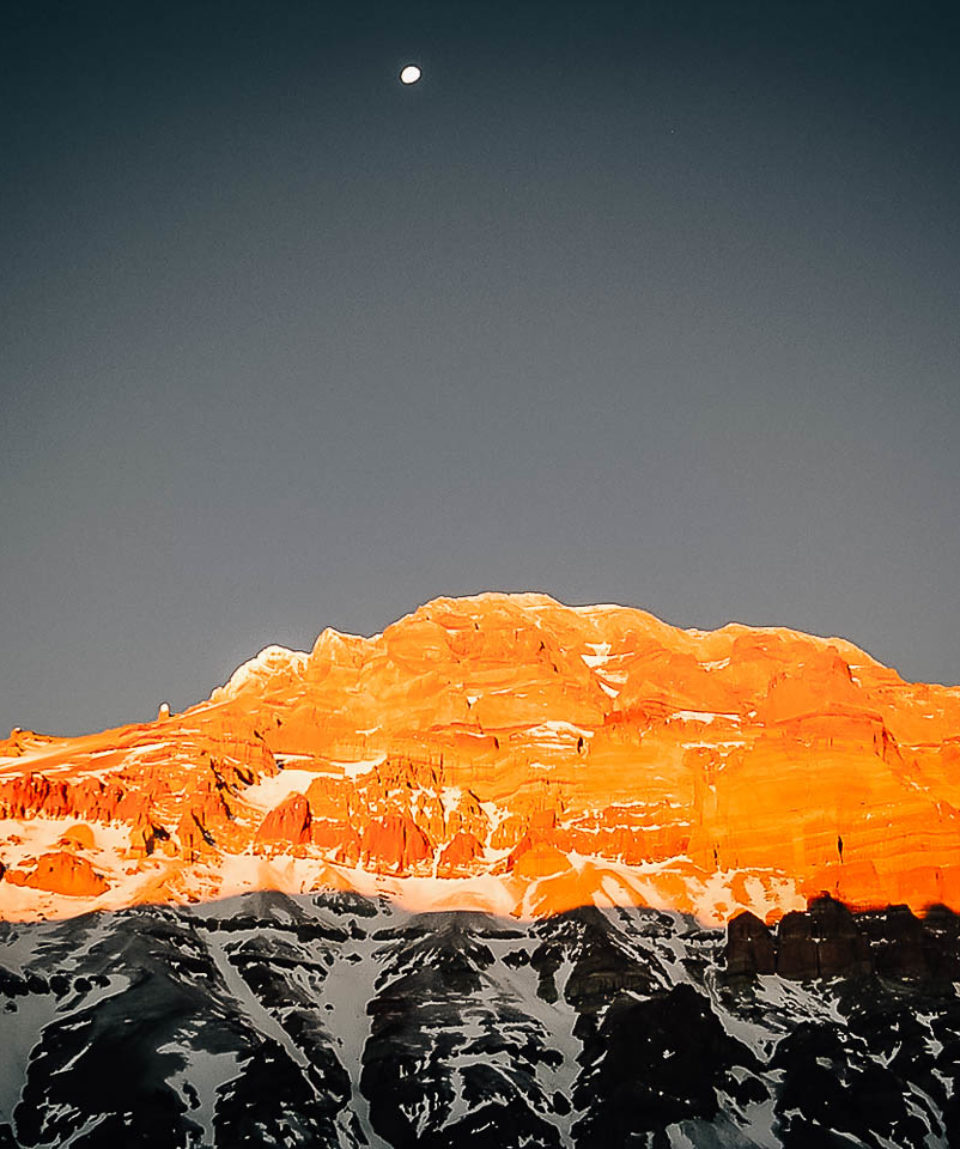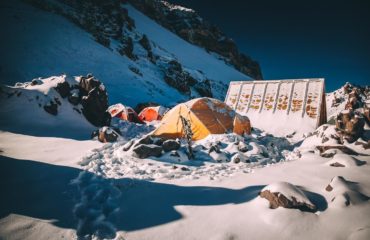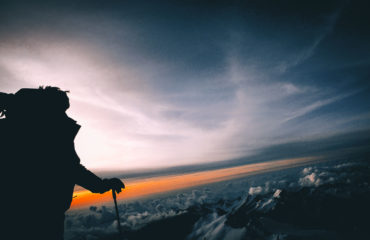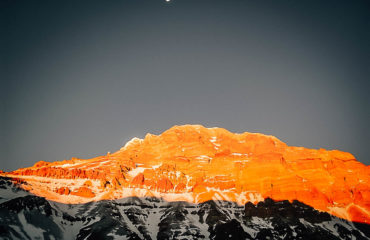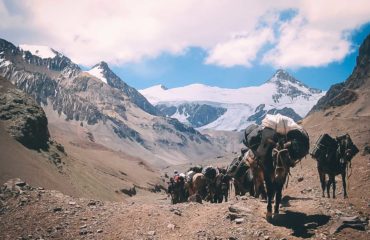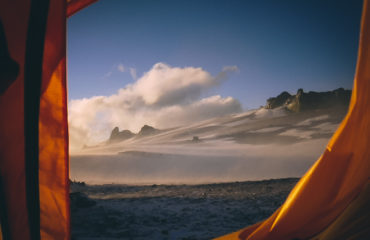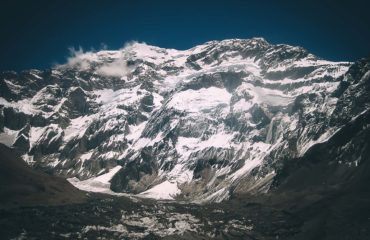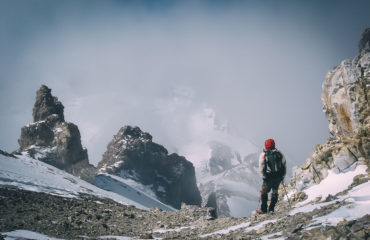Climb of Aconcagua 6962m: the roof of the Americas
fromThe climb of Aconcagua is world-famous and do you know why? The mountains of Aconcagua is one of the 7 Summits of the world. This makes it a hotspot for mountaineers from all over the world. Out of the famous seven, this mythical summit of almost 7000 m is considered to be the least difficult. However, climbing the roof of the Americas is still a difficult yet adventurous journey.
At the top of the mountain, you are delighted with mystic and spectacular views of pampa and the region of Mendoza in the east. If the sky is clear enough, you may see the majestic Pacific Ocean in the west. The northwest ridge is the recommended side to climb the summit. Because of its location in the southern hemisphere, this route is mostly snow-free, and mountaineers visit it all year round. If you are looking to conquer the famous seven summits of the world, then book us now and start your climb of Aconcagua!
- Reviews 0 Reviews0/5
- Style Type
- Chile
- Culture
- Expedition
- Mountainous
- Peak
-
- Level Tough
- Group Size Medium Group
The climb of Aconcagua is world-famous and do you know why? The mountains of Aconcagua is one of the 7 Summits of the world. This makes it a hotspot for mountaineers from all over the world. Out of the famous seven, this mythical summit of almost 7000 m is considered to be the least difficult. However, climbing the roof of the Americas is still a difficult yet adventurous journey.
At the top of the mountain, you are delighted with mystic and spectacular views of pampa and the region of Mendoza in the east. If the sky is clear enough, you may see the majestic Pacific Ocean in the west. The northwest ridge is the recommended side to climb the summit. Because of its location in the southern hemisphere, this route is mostly snow-free and mountaineers visit it all year round. If you are looking to conquer the famous seven summits of the world, then book us now and start your adventure!
The highlights of this trip are:
- The highest peak in America at nearly 7000 m
- One of the 7 Summits and a summit accessible to amateur trekkers
- Argentine high mountain guide
- Presence of an assistant-guide for more than security and flexibility
- Small private group of 4 to 6 participants to optimize its chances of success
- Argentina travel adviceby GOV.UK on 01/10/2024 at 2:01 pm
Updated information on street crime and new information on surrogacy and wildfires ('Safety and security' page).
- Day 1 DEPARTURE FROM EUROPE
- Day 2 MENDOZA
- Day 3 MENDOZA - PENITENTES
- Day 4 PENITENTS - CERRO BASIC CAMP PENITENTS
- Day 5 ASCENSION OF CERRO PENITENTS 4 351 M
- Day 6 PENITENTES - CONFLUENCIA
- Day 7 CONFLUENCIA - PLAZA FRANCIA 4000 M - CONFLUENCIA Early
- Day 8 CONFLUENCIA - BASIC CAMP PLAZA OF MULAS
- Day 9 PLAZA DE MULAS
- Day 10 ASCENSION OF CERRO BONETE 5 100 M - PLAZA DE MULAS Early
- Day 11 PLAZA DE MULAS
- Day 12 PLAZA DE MULAS - NIDO DE CONDORES
- Day 13 NIDO DE CONDORES - PLAZA DE MULAS
- Day 14 TO 18 ASCENSION OF THE ACONCAGUA 6 962 M
- Day 19 PLAZA OF MULAS - PUENTE DEL INCA - MENDOZA
- Day 20 RETURN TO EUROPE
- Day 21 ARRIVAL IN EUROPE
ACCOMMODATION
In a good standard hotel with double room in Mendoza, in a refuge in Penitentes and in a tent during the rest of the trip.
MEALS
Full meal provided throughout the climb (altitude food included). Free meals in Mendoza.
Water: plan pellets (Micropur type or others) to disinfect the water you put in your bottle, depending on the source and on the advice of your guide. You can also buy mineral water on site (not included in the price) but its ecological balance is high therefore we do not recommend it.
This trip is one the most difficult ones that we offer. The combined daily altitude differences can reach 1,000 meters. We operate in isolated environments where the security of the group depends on the endurance and ability of each participant. Team spirit is also essential in such expeditions
Each participant must wear his personal belongings.
The ascent of the Aconcagua presents no difficulty and that is what constitutes its weak point and presents a real danger if one does not prepare seriously. It is an adventure in the world of very high altitude and it requires to think seriously, well upstream, how to manage this experience. To do this we strongly advise you to devote a day or a weekend (date to be agreed) to establish together rules that will be benchmarks for you and which constitute a guarantee of security.
No visa for UK, Belgian or Swiss nationals, for a stay of less than three months. For other nationalities, inquire at the consulate or embassy. Passport requirement valid and valid for 6 months after the date of return. However, a visa will be required if your flight stops in the USA (see EASA online simplified procedure) These formalities may change and we thank you for checking the conditions of entry with the consular authorities of the country visited. these formalities
For your trip, plan 15 to 18 kg maximum, outside of your hand luggage, even if in most flights you will be entitled to 20 kg in the hold and 10 kg in the cabin. There is no point in being too busy and a little space is available to bring back memories. Attention, any extra and overweight bag will be charged directly by the airline during check-in. If you have domestic flights, check that there are no specific baggage restrictions. Finally, note that security checks have become very strict at airports: put the knives, scissors, nail files in your hold bag, the same for bottles and tubes of more than 100 ml
CLOTHING
You need several layers to add or remove depending on the temperature and your activity. You’ll be able to wash some quick-drying things on the way, including underwear and socks. For T-shirts, underwear and socks, plan to change 2-3 times a week if you do not wash anything on the way. In countries with insects, prefer dark coloured clothes (but neither black nor dark blue).
- Gore-Tex® waterproof and breathable jacket and pants
- Poncho or rain cape
- Pants and fleece jacket
- Clothes technical first layer, top and bottom.
- Lightweight trousers
- Fine gloves made of synthetic fibres.
- Wool or polar fleece slippers (to accept small gloves)
- Sur-protection mittens.
- Hat, cap or headband to protect from the sun
- Mountain pass or hood (cold + wind). Facial mask.
- Buff or scarf (neck)
- Down jacket
SHOES
- A pair of walking shoes, which you are used to (to avoid blisters) for hiking trails
- Shell warm shoes for altitude
- Gaiters
- Technical fine socks and warm woollen socks
- A pair of lighter walking shoes, which will be useful for flights, transfers, site visits and parties
Please follow the link for the latest health advice




